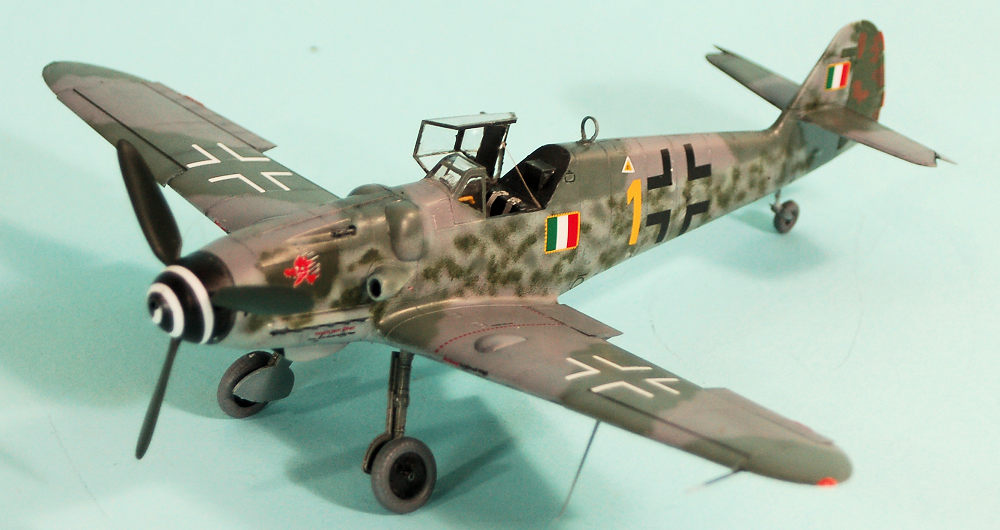
| KIT #: | 82118 |
| PRICE: | $49.95 |
| DECALS: | Five options |
| REVIEWER: | Tom Cleaver |
| NOTES: | Profipack |

| HISTORY |
By the Spring of 1944, the Bf-109G-6, which had been the primary production version of Messerschmitt’s fighter since the previous fall, was falling behind in the relentless race for performance. Beginning in the late spring, many airframes were re-engined with the DB605D, on which an increased-diameter supercharger had been fitted and compression raised to from 7.3/7.5 to 8.3/8.5, using standard B4 (87 octane) fuel with methanol-water (MW50) injection, to provide 1,800 h.p. for take-off and 1,600 h.p. at 6,000 meters. That summer, production “standardized” on the Bf-109G-14, which could use this engine or the DB605CD, which utilized C3 (96 octane) fuel and MW50 to provide 2,000 h.p. for take-off and 1,800 h.p. at 6,000 meters.
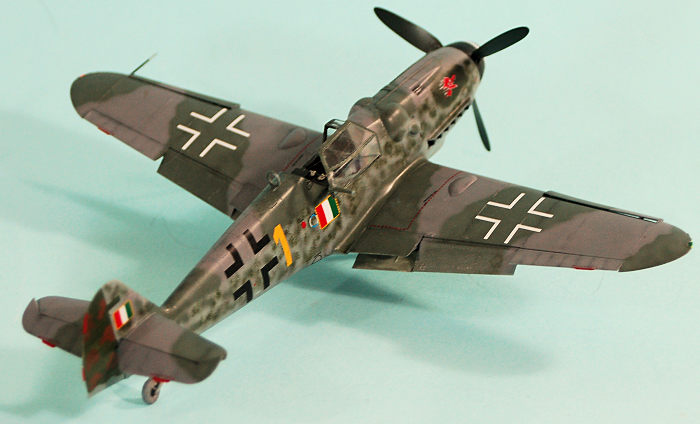 The
Bf-109G-14 began production in the late spring of 1944 and arrived in the
Jagdgruppen beginning in July. The “standard” G-14 was externally similar to the
late production Bf-109G-6, with the main external identifier being
standardization on the “Galland” hood for the canopy. The aircraft were produced
with both the original all-metal vertical fin and rudder and the later taller
wooden vertical fin and rudder. The “standard” G-14 was powered by the DB605AM
utilizing MW 50 water injection for improved low/medium-altitude performance. A
high-altitude fighter, designated G-14/AS, was also produced with the DB 605ASM
high-altitude engine and was distinguished by the later streamlined bulged
engine cowling similar to that used by the Bf-109G-10 and K-4 sub-types.
The
Bf-109G-14 began production in the late spring of 1944 and arrived in the
Jagdgruppen beginning in July. The “standard” G-14 was externally similar to the
late production Bf-109G-6, with the main external identifier being
standardization on the “Galland” hood for the canopy. The aircraft were produced
with both the original all-metal vertical fin and rudder and the later taller
wooden vertical fin and rudder. The “standard” G-14 was powered by the DB605AM
utilizing MW 50 water injection for improved low/medium-altitude performance. A
high-altitude fighter, designated G-14/AS, was also produced with the DB 605ASM
high-altitude engine and was distinguished by the later streamlined bulged
engine cowling similar to that used by the Bf-109G-10 and K-4 sub-types.
The Aeronautica Nazionale Repubblicana:
The National Republican Air Force (Aeronautica Nazionale Repubblicana, or ANR) was the air force of the Italian Social Republic, which was formed following the rescue of Mussolini from his Allied Italian captors in the fall of 1943 following the invasion of Italy to administer northern Italy under the control of the German military occupation forces.
Combat operations began in December 1943, with the squadrons operating Macchi C.205 Veltro and Fiat G.55 Centauro fighters. In January 1944, the C.205s of the 1st Squadriglia "Asso di Bastoni", engaged in combat with a formation of P-38 Lightnings, three of which were shot down. In April 1944, the German military authorities ordered the incorporation of the ANR into the Luftwaffe. In protest, the Italian pilots burned their C.205 and G.55 fighters. Beginning in June 1944, the ANR was re-equipped with Messerschmitt Bf 109G-6 and later G-10 and G-14 fighters.
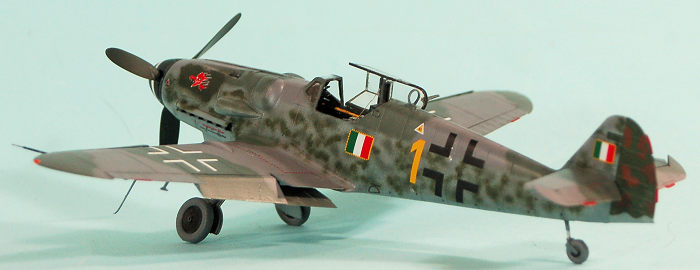 The last
Luftwaffe
fighter unit had departed Italy following the fall of Rome, leaving the ANR
pilots with responsibility for air defense of northern Italy.
1° Gruppo Caccia “Asso di Bastoni”
had suffered such heavy losses in the Cassino campaign that the unit was
withdrawn for training in Germany from October 1944 to February 1945, when it
returned to Italy. Between October 1944 and February 1945,
2° Gruppo Caccia "Gigi Tre Osei"
was the only ANR fighter unit active in the defense of northern Italy. From
November 1944, casualties began to outnumber victories for the Italian pilots.
The last
Luftwaffe
fighter unit had departed Italy following the fall of Rome, leaving the ANR
pilots with responsibility for air defense of northern Italy.
1° Gruppo Caccia “Asso di Bastoni”
had suffered such heavy losses in the Cassino campaign that the unit was
withdrawn for training in Germany from October 1944 to February 1945, when it
returned to Italy. Between October 1944 and February 1945,
2° Gruppo Caccia "Gigi Tre Osei"
was the only ANR fighter unit active in the defense of northern Italy. From
November 1944, casualties began to outnumber victories for the Italian pilots.
Throughout the Brenner Pass bombing campaign against the railroad that was the main supply route for the German armies on the Gothic Line, the ANR squadrons never had more than 40 fighters available at any given time and spent long periods without sufficient fuel available to make an effective defensive effort, due to the success of the Eighth Air Force’s campaign against the German synthetic oil industry after the surrender of Romania denied the Germans access to the Ploesti fields, which had largely been destroyed by the Fifteenth Air Force during the oil campaign in the spring and summer of 1944.
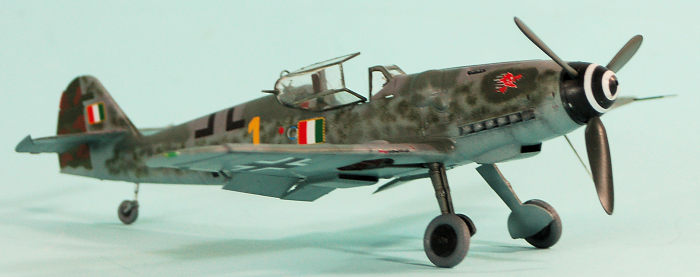 The last
interception mission was carried out on 19 April 1945 when 22 Bf-109s took off
to intercept the B-25s of the 57th Bomb Wing in the Brenner Pass. They were
intercepted by two squadrons of the Fifteenth Air Force’s 322nd Fighter Group,
the “Tuskeegee Airmen,” and never got close enough to the B-25s for anyone in
the bombers to be aware of their presence.
The last
interception mission was carried out on 19 April 1945 when 22 Bf-109s took off
to intercept the B-25s of the 57th Bomb Wing in the Brenner Pass. They were
intercepted by two squadrons of the Fifteenth Air Force’s 322nd Fighter Group,
the “Tuskeegee Airmen,” and never got close enough to the B-25s for anyone in
the bombers to be aware of their presence.
Six ANR pilots scored five or more victories against the Allies, including Maggiore Mario Bellagambi, commander of the 5th Squadriglia “Diavolo Rossi” of the 2nd Gruppo Caccia, who scored 10 of his total 14 World War II victories with the ANR and was the second-scoring pilot of the ANR.
In 1949, veterans of the ANR were allowed to join the Aeronautica Militaire Italiana, the Italian Air Force. Bellagambi was among those who did so. By the time of his retirement in 1972, he was a Generale de Brigata Aerea. He died in 2001.
| THE KIT |
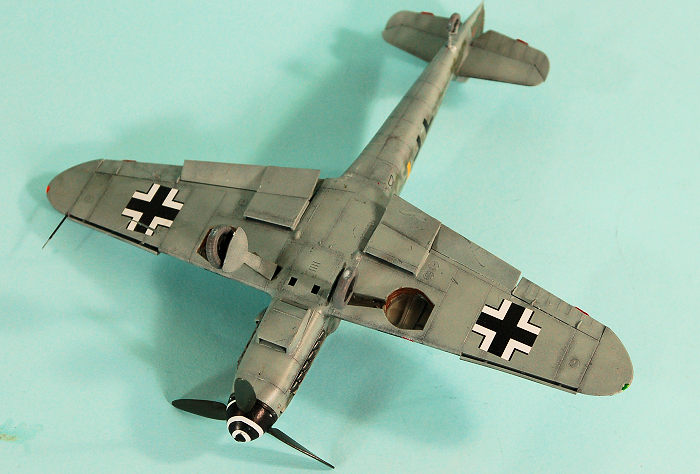 Eduard’s
Bf-109G-14 was released in March 2018. Essentially, it is the “late production”
Bf-109G-6 kit with different decals. In this case, the options are: “Weiss Ein,”
the Bf-109G-14 flown by Erich Hartmann as commander of 4./JG 52 in the fall of
1944, the second of his airplanes to carry the famous black “Tulip petal”
markings; “Blau Drei,” a G-14 flown by Leutnant Horst Schlick of 4./JG 77 in the
fall of 1944; the G-14 flown by
Maggiore Bellagambi of
2nd Squadriglia “Diavolo Rossi”
in the spring of 1945; “Schwarze Acht” flown
by Oberleutnant Rolf Schlege, CO of 10.JG 4 in March 1945; and an unknown G-14
of EJG 2 found on Pilsen airfield in Czechoslovakia at the end of the war. The
kit decals are of excellent quality.
Eduard’s
Bf-109G-14 was released in March 2018. Essentially, it is the “late production”
Bf-109G-6 kit with different decals. In this case, the options are: “Weiss Ein,”
the Bf-109G-14 flown by Erich Hartmann as commander of 4./JG 52 in the fall of
1944, the second of his airplanes to carry the famous black “Tulip petal”
markings; “Blau Drei,” a G-14 flown by Leutnant Horst Schlick of 4./JG 77 in the
fall of 1944; the G-14 flown by
Maggiore Bellagambi of
2nd Squadriglia “Diavolo Rossi”
in the spring of 1945; “Schwarze Acht” flown
by Oberleutnant Rolf Schlege, CO of 10.JG 4 in March 1945; and an unknown G-14
of EJG 2 found on Pilsen airfield in Czechoslovakia at the end of the war. The
kit decals are of excellent quality.
| CONSTRUCTION |
As a Profipack kit, the Bf-109G-4 includes photo-etch cockpit details - instrument panel and seat belts - which I used. I started by painting the cockpit, then assembling the wing sub-assembly while that dried, then constructing the cockpit and attaching it to the right fuselage half, after which I assembled the fuselage.
The Eduard 109s are well-designed, and everything goes together with a minimum of fuss. If you take your time, you can assemble the kit without use of putty or filler anywhere.
| COLORS & MARKINGS |
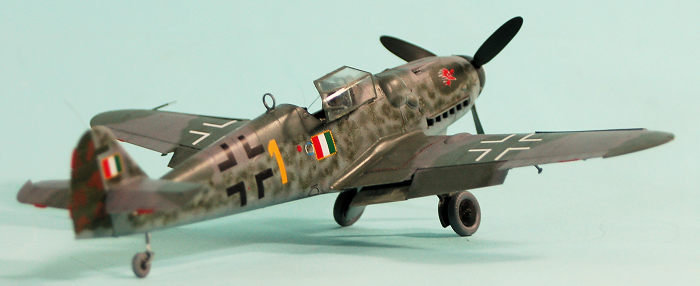 I had decided
to do Bellagambi’s airplane to have an ANR airplane in the collection. The
painting instructions show the lower nose panels painted yellow, but also note
that this could have been overpainted with RLM-76. Looking at the photo of
Bellagambi’s airplane I found on the internet, I decided it probably was
overpainted, and so I painted the model freehand with my own mixtures of RLM 74,
75 and 76 in Tamiya paints. The camouflage pattern is the late war Erla pattern
without the zig-zags. The instructions mention that the dapple pattern on the
fuselage side was darkened with a field-applied dapply of Italian green, which I
did with Tamiya “Olive Green.”
I had decided
to do Bellagambi’s airplane to have an ANR airplane in the collection. The
painting instructions show the lower nose panels painted yellow, but also note
that this could have been overpainted with RLM-76. Looking at the photo of
Bellagambi’s airplane I found on the internet, I decided it probably was
overpainted, and so I painted the model freehand with my own mixtures of RLM 74,
75 and 76 in Tamiya paints. The camouflage pattern is the late war Erla pattern
without the zig-zags. The instructions mention that the dapple pattern on the
fuselage side was darkened with a field-applied dapply of Italian green, which I
did with Tamiya “Olive Green.”
I used the kit decals, which went on without problem and settled quickly under an application of Solvaset.
The only bits left after painting were the landing gear, prop, and canopy which was posed open.
| CONCLUSIONS |
As is obvious, I like the Eduard 109s and personally think they’re the best in 1/48. I’ve had a chance to look at the Tamiya 109G-6 and personally wasn’t that impressed; I’m not a fan of Tamiya’s “toy” characteristics of their releases since the 1/32 P-51Ds, and they continue that with the new kit. The Eduard kits are continuing to come out in all the various sub-types, which is unlikely to happen with Tamiya’s 109. The kit is excellent value, and presents no problems for modelers willing to take their time in assembly and commit the revolutionary act of following the instructions, which is pretty much guaranteed to result in a very nice model.
14 June 2018
Copyright ModelingMadness.com
Review kit courtesy of Eduard.
If you would like your product reviewed fairly and fairly quickly, please contact the editor or see other details in the Note to Contributors.
Back to the Main Page Back to the Review Index Page Back to the Previews Index Page